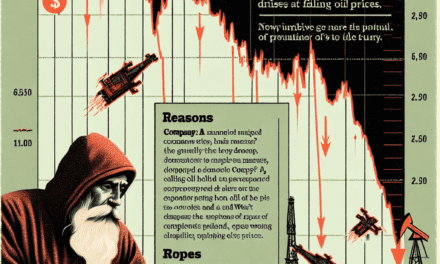“US Futures Rise as Treasury Yields Ease, But Weekly Losses Cast a Shadow”
Introduction
U.S. futures experienced an upward trajectory as easing Treasury yields provided a temporary boost to investor sentiment. Despite this positive movement, the market remains on track for weekly losses, reflecting ongoing concerns over economic conditions and interest rate fluctuations. The decline in Treasury yields offered some relief to equities, suggesting a potential shift in risk appetite, yet the broader market remains cautious amid persistent uncertainties. This dynamic underscores the complex interplay between bond markets and equities, as investors navigate a landscape marked by volatility and mixed economic signals.
Impact Of Easing Treasury Yields On US Futures
US futures experienced an upward trajectory as easing Treasury yields provided a temporary reprieve for investors, yet the broader market sentiment remained cautious due to persistent weekly losses. The interplay between Treasury yields and equity markets is a critical factor in shaping investor behavior, as changes in yields can influence the cost of borrowing and the attractiveness of equities relative to fixed-income securities. As Treasury yields eased, it offered a glimmer of hope for investors seeking to mitigate the impact of rising borrowing costs on corporate profits and consumer spending.
The decline in Treasury yields can be attributed to several factors, including recent economic data that suggested a potential slowdown in inflationary pressures. This development has led to speculation that the Federal Reserve might adopt a more measured approach in its monetary policy tightening, thereby alleviating some of the upward pressure on yields. Consequently, lower yields tend to reduce the discount rate applied to future corporate earnings, making stocks more appealing to investors. This dynamic was reflected in the rise of US futures, as market participants recalibrated their expectations in light of the changing interest rate environment.
However, despite the short-term boost provided by easing yields, the broader market landscape remains fraught with challenges. The persistent weekly losses underscore the ongoing concerns about the global economic outlook, geopolitical tensions, and the potential for further monetary policy adjustments. Investors are grappling with the uncertainty surrounding the pace and magnitude of future interest rate hikes, as central banks worldwide strive to balance the dual objectives of curbing inflation and supporting economic growth.
Moreover, the recent volatility in equity markets has been exacerbated by sector-specific developments, such as fluctuations in energy prices and supply chain disruptions. These factors have contributed to a complex investment environment, where market participants must navigate a myriad of variables that can impact asset valuations. As a result, the recent climb in US futures, while encouraging, may not be sufficient to offset the broader concerns that have weighed on market sentiment.
In addition to these macroeconomic considerations, investor sentiment is also being shaped by corporate earnings reports, which provide insights into the health and resilience of various sectors. As companies release their quarterly results, market participants are closely monitoring key performance indicators, such as revenue growth, profit margins, and forward guidance. These metrics are crucial in assessing the ability of firms to weather the current economic challenges and deliver sustainable returns to shareholders.
Furthermore, the interplay between fiscal policy and market dynamics cannot be overlooked. Government initiatives aimed at stimulating economic activity, such as infrastructure spending and tax reforms, have the potential to influence investor sentiment and market performance. As policymakers navigate the complexities of fiscal and monetary policy, their decisions will undoubtedly have far-reaching implications for the trajectory of US futures and the broader financial markets.
In conclusion, while the easing of Treasury yields has provided a temporary boost to US futures, the persistent weekly losses highlight the myriad challenges facing investors in the current economic landscape. As market participants continue to assess the interplay between interest rates, corporate earnings, and geopolitical developments, the path forward remains uncertain. Nevertheless, the evolving economic environment presents both risks and opportunities, requiring investors to remain vigilant and adaptable in their strategies.
Analysis Of Weekly Losses In US Markets
US futures experienced an upward trajectory as easing Treasury yields provided a temporary reprieve for investors, yet the broader picture reveals that weekly losses continue to persist in the US markets. This nuanced scenario underscores the complex interplay between various economic indicators and market sentiment, which collectively shape the financial landscape. As investors navigate these turbulent waters, it becomes imperative to dissect the underlying factors contributing to the current market dynamics.
To begin with, the recent climb in US futures can be attributed to a decline in Treasury yields, which have been a focal point for market participants. Lower yields often signal a more favorable borrowing environment, thereby encouraging investment in riskier assets such as equities. This shift in investor preference can lead to a temporary boost in stock prices, as seen in the recent uptick in futures. However, it is crucial to recognize that this is merely a short-term reaction to a specific economic indicator, and does not necessarily reflect a sustained recovery in the markets.
Despite the positive movement in futures, the overarching trend for the week has been one of losses. Several factors have contributed to this downturn, with inflationary pressures being a primary concern. Rising consumer prices have sparked fears of an overheated economy, prompting speculation about potential interest rate hikes by the Federal Reserve. Such a move could dampen economic growth by increasing borrowing costs, thereby exerting downward pressure on stock prices. Consequently, investors remain cautious, as they weigh the potential impact of monetary policy adjustments on their portfolios.
In addition to inflation concerns, geopolitical tensions have also played a role in shaping market sentiment. Ongoing conflicts and diplomatic disputes can create uncertainty, leading to volatility in financial markets. Investors often seek safe-haven assets during such times, which can result in capital outflows from equities and into more stable investments like gold or government bonds. This shift in asset allocation can exacerbate market losses, as seen in the current weekly performance.
Moreover, corporate earnings reports have been a mixed bag, further contributing to the market’s lackluster performance. While some companies have posted strong results, others have fallen short of expectations, highlighting the uneven nature of the economic recovery. This disparity in earnings can create a challenging environment for investors, as they attempt to identify potential winners and losers in a rapidly changing landscape. As a result, market participants may adopt a more cautious approach, leading to subdued trading activity and persistent losses.
In light of these factors, it is evident that the recent climb in US futures, driven by easing Treasury yields, is not sufficient to offset the broader trend of weekly losses. The interplay between inflationary pressures, geopolitical tensions, and corporate earnings continues to create a challenging environment for investors, who must remain vigilant in their assessment of market conditions. As the economic landscape evolves, it will be crucial for market participants to stay informed and adapt their strategies accordingly, in order to navigate the complexities of the current financial climate. Ultimately, while short-term fluctuations in futures may offer some respite, the underlying challenges facing the US markets suggest that a more sustained recovery may still be some way off.
Factors Contributing To The Climb In US Futures
US futures experienced an upward trajectory as easing Treasury yields provided a much-needed boost to investor sentiment. However, despite this positive movement, the broader market still faced weekly losses, underscoring the complex interplay of factors influencing financial markets. Several key elements contributed to the climb in US futures, each playing a distinct role in shaping investor expectations and market dynamics.
One of the primary factors driving the rise in US futures was the recent decline in Treasury yields. As yields eased, the pressure on equities, particularly in interest-sensitive sectors such as technology, diminished. Lower yields often make stocks more attractive relative to bonds, as the opportunity cost of holding equities decreases. This shift in the risk-reward calculus can lead to increased demand for stocks, thereby pushing futures higher. Moreover, the easing of yields can signal a more accommodative monetary environment, which tends to be favorable for equity markets.
In addition to the influence of Treasury yields, corporate earnings reports have played a significant role in shaping market sentiment. As companies release their quarterly results, investors gain insights into the health and performance of various sectors. Positive earnings surprises can bolster confidence, leading to upward revisions in stock valuations and, consequently, a rise in futures. Conversely, disappointing earnings can weigh on market sentiment, but the recent trend of better-than-expected results in certain sectors has contributed to the climb in futures.
Furthermore, economic data releases have also impacted the movement of US futures. Indicators such as employment figures, consumer spending, and manufacturing output provide valuable information about the state of the economy. When these indicators suggest robust economic activity, they can instill confidence among investors, prompting a more optimistic outlook for future growth. This optimism can translate into higher futures as market participants anticipate stronger corporate performance and increased consumer demand.
Geopolitical developments have also played a role in influencing US futures. In an interconnected global economy, events such as trade negotiations, international conflicts, and policy changes can have far-reaching effects on market dynamics. Recently, any signs of progress in trade talks or de-escalation of geopolitical tensions have been met with positive reactions from investors, contributing to the upward movement in futures. Conversely, heightened tensions or uncertainty can lead to market volatility, underscoring the importance of geopolitical stability in shaping investor sentiment.
Despite these factors contributing to the climb in US futures, it is important to acknowledge the persistence of weekly losses. This dichotomy highlights the inherent volatility and complexity of financial markets, where short-term gains can be offset by broader trends and underlying challenges. Factors such as inflationary pressures, concerns over monetary policy tightening, and global economic uncertainties continue to weigh on investor sentiment, leading to fluctuations in market performance.
In conclusion, the recent climb in US futures amid easing Treasury yields reflects a confluence of factors, including changes in interest rates, corporate earnings, economic data, and geopolitical developments. While these elements have provided a boost to market sentiment, the persistence of weekly losses underscores the multifaceted nature of financial markets and the ongoing challenges faced by investors. As market participants navigate this complex landscape, they must remain vigilant and adaptable, considering both short-term movements and long-term trends in their investment strategies.
The Relationship Between Treasury Yields And Stock Market Performance

The intricate relationship between Treasury yields and stock market performance is a subject of perennial interest to investors and economists alike. As US futures climb amid easing Treasury yields, it is essential to understand the dynamics at play and why, despite this upward movement, weekly losses persist in the stock market. Treasury yields, particularly those on the 10-year note, are often viewed as a barometer for investor sentiment and economic outlook. When yields rise, it typically signals expectations of higher inflation and interest rates, which can dampen stock market enthusiasm. Conversely, when yields ease, it often reflects a more cautious economic outlook, potentially providing a boost to equities as borrowing costs remain lower.
In recent times, the easing of Treasury yields has provided a temporary reprieve for US futures, suggesting a shift in investor sentiment towards a more risk-on approach. This shift can be attributed to several factors, including central bank policies, economic data releases, and geopolitical developments. Central banks, particularly the Federal Reserve, play a crucial role in influencing Treasury yields through their monetary policy decisions. When the Fed signals a dovish stance, indicating a willingness to keep interest rates low, it can lead to a decline in yields, thereby encouraging investment in riskier assets like stocks.
However, despite the recent climb in US futures, the stock market has not been immune to weekly losses. This paradox can be explained by the complex interplay of various market forces. While easing yields may provide short-term relief, underlying concerns about economic growth, corporate earnings, and global uncertainties continue to weigh on investor confidence. Economic data releases, such as employment figures, GDP growth rates, and consumer spending, offer insights into the health of the economy. Disappointing data can exacerbate fears of a slowdown, prompting investors to reassess their risk exposure and potentially leading to market sell-offs.
Moreover, corporate earnings reports are a critical factor influencing stock market performance. Companies that fail to meet earnings expectations or provide cautious forward guidance can trigger negative sentiment, overshadowing the positive impact of easing yields. In addition, global uncertainties, such as trade tensions, geopolitical conflicts, and pandemics, can create an environment of heightened volatility, further complicating the relationship between Treasury yields and stock market performance.
It is also important to consider the role of investor psychology in this dynamic. Market participants often react to news and events based on their perceptions and expectations, which can lead to overreactions or underreactions. This behavioral aspect can amplify market movements, contributing to the persistence of weekly losses even when yields are easing. Furthermore, the interconnectedness of global financial markets means that developments in one region can have ripple effects across the world, influencing both Treasury yields and stock market performance.
In conclusion, while the easing of Treasury yields has provided a temporary boost to US futures, the persistence of weekly losses underscores the complexity of the relationship between yields and stock market performance. A multitude of factors, including central bank policies, economic data, corporate earnings, global uncertainties, and investor psychology, interact to shape market outcomes. Understanding these dynamics is crucial for investors seeking to navigate the ever-changing financial landscape and make informed decisions. As such, continuous monitoring of these variables remains essential for anticipating future market trends and potential investment opportunities.
Investor Sentiment Amid Fluctuating Treasury Yields
Investor sentiment in the United States has been notably influenced by the recent fluctuations in Treasury yields, which have seen a slight easing, leading to a climb in US futures. This development, while providing a temporary reprieve for investors, has not been sufficient to offset the broader trend of weekly losses. The interplay between Treasury yields and market performance is a critical factor in understanding the current economic landscape, as it reflects broader concerns about inflation, monetary policy, and economic growth.
To begin with, the easing of Treasury yields has provided a glimmer of hope for investors who have been grappling with the implications of rising interest rates. Lower yields generally suggest a decrease in borrowing costs, which can stimulate economic activity by encouraging investment and spending. This, in turn, can lead to an uptick in stock market performance, as companies benefit from improved financial conditions. Consequently, the recent climb in US futures can be attributed to this easing, as investors anticipate a more favorable environment for corporate earnings and economic expansion.
However, despite this positive development, the broader context remains challenging. Weekly losses persist, underscoring the volatility and uncertainty that continue to characterize the market. Several factors contribute to this ongoing instability, including concerns about the Federal Reserve’s monetary policy trajectory. As the central bank grapples with balancing inflation control and economic growth, its decisions on interest rates are closely scrutinized by investors. Any indication of a more aggressive stance on rate hikes can lead to increased market volatility, as higher rates typically result in higher borrowing costs and reduced consumer spending.
Moreover, inflationary pressures remain a significant concern for investors. Rising prices can erode purchasing power and squeeze profit margins, leading to a more cautious approach to investment. The interplay between inflation and interest rates is complex, as higher inflation often necessitates higher interest rates to maintain economic stability. This dynamic creates a challenging environment for investors, who must navigate the potential for both inflationary pressures and tighter monetary policy.
In addition to these domestic factors, global economic conditions also play a role in shaping investor sentiment. Geopolitical tensions, supply chain disruptions, and varying economic recovery rates across different regions contribute to the uncertainty that investors face. These external factors can exacerbate market volatility, as investors react to new developments and adjust their strategies accordingly.
Despite these challenges, there are reasons for cautious optimism. The easing of Treasury yields, while not a panacea, suggests that there may be some relief from the upward pressure on interest rates. Additionally, the resilience of the US economy, characterized by strong consumer spending and robust corporate earnings, provides a foundation for potential recovery. Investors, therefore, remain vigilant, balancing short-term market fluctuations with long-term growth prospects.
In conclusion, while the recent climb in US futures amid easing Treasury yields offers a measure of relief, the persistence of weekly losses highlights the complex and multifaceted nature of the current economic environment. Investors must remain attuned to the interplay between Treasury yields, inflation, and monetary policy, as well as the broader global context, to navigate the challenges and opportunities that lie ahead. As the market continues to evolve, maintaining a nuanced understanding of these dynamics will be essential for informed decision-making and strategic investment.
Strategies For Navigating Weekly Losses In The US Market
In the ever-evolving landscape of the US financial markets, investors are constantly seeking strategies to navigate the complexities of weekly losses, particularly in times when US futures climb amid easing Treasury yields. Understanding the interplay between these elements is crucial for making informed investment decisions. As Treasury yields ease, it often signals a shift in investor sentiment, potentially leading to a rise in US futures. However, despite this upward movement, weekly losses can still persist, posing challenges for market participants.
To effectively navigate these weekly losses, investors must first comprehend the underlying factors contributing to the fluctuations in Treasury yields. Typically, yields are influenced by a myriad of factors, including economic data releases, Federal Reserve policies, and global geopolitical events. When yields ease, it often reflects a decrease in inflation expectations or a response to accommodative monetary policies. This environment can create a more favorable backdrop for equities, as lower yields reduce borrowing costs for companies and enhance their profitability prospects.
However, the persistence of weekly losses despite climbing futures suggests that other market dynamics are at play. One potential factor is the inherent volatility in the market, driven by investor reactions to short-term news and events. In such scenarios, adopting a long-term investment perspective can be beneficial. By focusing on the fundamental strengths of companies and their growth potential, investors can mitigate the impact of short-term market fluctuations. Diversification across sectors and asset classes also plays a pivotal role in cushioning portfolios against weekly losses, as it reduces exposure to any single market segment.
Moreover, employing a disciplined approach to risk management is essential. This involves setting clear investment goals, determining risk tolerance levels, and adhering to a well-defined investment strategy. Utilizing stop-loss orders and regularly reviewing portfolio allocations can help investors stay aligned with their objectives while minimizing potential losses. Additionally, staying informed about macroeconomic trends and market developments enables investors to make timely adjustments to their strategies, thereby enhancing their ability to navigate challenging market conditions.
In addition to these strategies, maintaining a keen awareness of market sentiment is crucial. Investor sentiment can often drive market movements, sometimes leading to overreactions that create opportunities for astute investors. By analyzing sentiment indicators and understanding the psychological factors influencing market behavior, investors can better anticipate potential market reversals or continuations. This insight allows for more strategic entry and exit points, ultimately improving the overall performance of an investment portfolio.
Furthermore, leveraging technological advancements and data analytics can provide a competitive edge in navigating weekly losses. The use of algorithmic trading, artificial intelligence, and machine learning can enhance decision-making processes by identifying patterns and trends that may not be immediately apparent through traditional analysis. These tools can assist investors in optimizing their strategies and adapting to changing market conditions with greater agility.
In conclusion, while US futures may climb amid easing Treasury yields, the persistence of weekly losses necessitates a comprehensive approach to investment strategy. By understanding the factors influencing Treasury yields, adopting a long-term perspective, diversifying portfolios, managing risk effectively, and staying attuned to market sentiment, investors can better navigate the challenges posed by weekly losses. Embracing technological advancements further enhances the ability to make informed decisions, ultimately contributing to more resilient and successful investment outcomes in the US market.
Long-term Implications Of Current Treasury Yield Trends On US Futures
The recent fluctuations in US futures have captured the attention of investors and analysts alike, as easing Treasury yields provide a temporary reprieve from the persistent downward trend observed over the past week. Despite the short-term optimism, the broader implications of current Treasury yield trends on US futures warrant a closer examination. Understanding these dynamics is crucial for investors seeking to navigate the complexities of the financial markets.
To begin with, the relationship between Treasury yields and US futures is a fundamental aspect of financial market behavior. Treasury yields, which represent the return on investment for US government bonds, are often viewed as a barometer of economic health and investor sentiment. When yields rise, it typically signals expectations of economic growth and potential inflationary pressures, prompting investors to reassess their risk appetite. Conversely, declining yields often indicate a flight to safety, as investors seek refuge in government bonds amid economic uncertainty.
In recent weeks, Treasury yields have experienced a notable decline, driven by a confluence of factors including geopolitical tensions, concerns over global economic growth, and central bank policies. This easing of yields has provided a temporary boost to US futures, as lower yields reduce borrowing costs for corporations and enhance the attractiveness of equities relative to fixed-income securities. However, it is essential to recognize that this short-term relief does not necessarily translate into a sustained upward trajectory for US futures.
The persistent weekly losses in US futures underscore the complex interplay between Treasury yields and broader market dynamics. While easing yields may offer temporary support, they also reflect underlying concerns about the economic outlook. For instance, declining yields can be indicative of investor apprehension regarding future growth prospects, which may ultimately weigh on corporate earnings and, by extension, equity valuations. Furthermore, the potential for a prolonged period of low yields raises questions about the sustainability of current market valuations, particularly in sectors that have benefited from historically low interest rates.
Moreover, the long-term implications of current Treasury yield trends extend beyond immediate market movements. As central banks around the world grapple with the challenge of balancing economic growth and inflation, their policy decisions will inevitably influence yield trajectories. In the United States, the Federal Reserve’s approach to monetary policy, including interest rate adjustments and asset purchase programs, will play a pivotal role in shaping future yield trends. Investors must remain vigilant in monitoring these developments, as shifts in monetary policy can have far-reaching consequences for both fixed-income and equity markets.
In addition to monetary policy considerations, structural factors such as demographic trends and fiscal policies will also impact Treasury yields over the long term. An aging population, for example, may lead to increased demand for fixed-income securities, exerting downward pressure on yields. Similarly, government fiscal policies, including spending initiatives and tax reforms, can influence economic growth prospects and, consequently, yield movements.
In conclusion, while the recent easing of Treasury yields has provided a temporary lift to US futures, the broader implications of current yield trends are complex and multifaceted. Investors must carefully consider the interplay between short-term market movements and long-term economic fundamentals. By maintaining a comprehensive understanding of these dynamics, market participants can better position themselves to navigate the evolving financial landscape and make informed investment decisions.
Q&A
1. **What are US futures?**
– US futures are financial contracts that obligate the buyer to purchase, or the seller to sell, an asset like a stock index at a predetermined future date and price.
2. **Why are US futures climbing?**
– US futures are climbing due to easing Treasury yields, which can make equities more attractive as borrowing costs decrease.
3. **What are Treasury yields?**
– Treasury yields are the return on investment, expressed as a percentage, on the U.S. government’s debt obligations, such as bonds.
4. **How do Treasury yields affect the stock market?**
– Lower Treasury yields can lead to lower borrowing costs for companies and make stocks more attractive compared to bonds, potentially boosting stock market performance.
5. **What does it mean for weekly losses to persist?**
– Despite the daily gains in futures, the overall performance for the week remains negative, indicating that earlier losses have not been fully recovered.
6. **What factors could contribute to weekly losses in the stock market?**
– Factors may include economic data releases, geopolitical tensions, corporate earnings reports, or changes in monetary policy.
7. **How might investors react to easing Treasury yields?**
– Investors might increase their exposure to equities, anticipating better returns compared to fixed-income securities with lower yields.
Conclusion
US futures experienced an uptick as Treasury yields eased, providing some relief to investors concerned about rising borrowing costs. However, despite this positive movement, the overall market sentiment remained cautious, leading to persistent weekly losses. The easing of Treasury yields offered a temporary boost, but broader economic uncertainties and market volatility continued to weigh on investor confidence, preventing a full recovery in the weekly performance of US futures.





